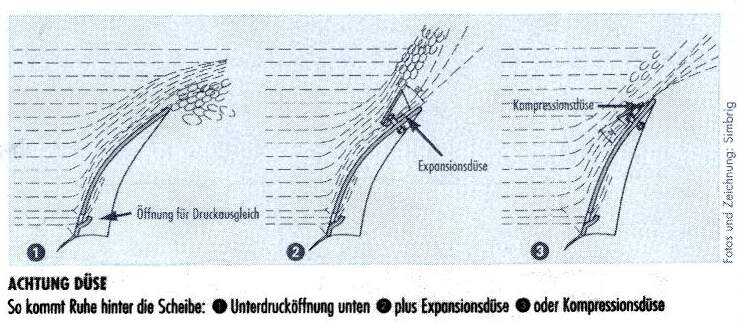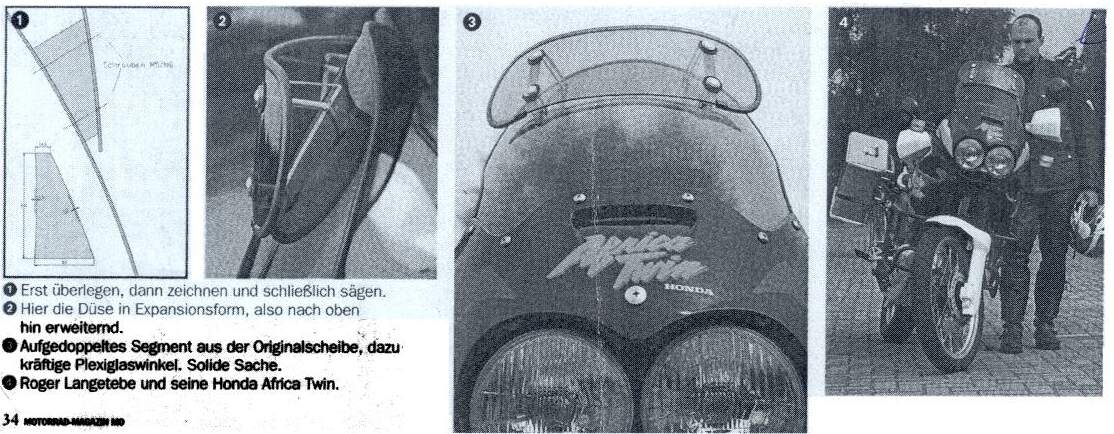Modifications to Wind-Screens
to Reduce Turbulence
Original author: Hans-Jochen
Simbrig (from Motorrad Magazine Mo)
Please read the Disclaimer before attempting any work in this FAQ.
This following text has been
translated from the an article originally published in Germany. I may not agree
with all the opinions expressed in the article, but I am not the author.
Personally, I have an original wind-screen which I am pretty happy with as I
rarely do any high-speed cruising on the freeways - I prefer to use the narrow
and bending roads. However, I may try the suggestion of cutting a slot in the
screen to see what difference it makes. I strongly advise you not to make any
permanent changes or modifications without experimenting first and as for
drilling into the screen, please seek expert advice as plastic can split very
quickly. Perhaps I might try using longer screws, spacers and some method of
keeping the screen stable to create a gap between screen and cockpit first and
see if that has an effect, before doing anything more drastic.
It wasn’t very long ago when all
motorcycles were “naked”. Nowadays they are called “Naked-Bikes” and are
basically an anachronism when they have a top-speed of 100mph and perhaps more.
An effective wind protection is sensible when high speed cruising and keeping up
with the other traffic on the road is desired.
In my opinion there are four main
types of wind-screen:
-
Wind-screens which look good but
which have little or almost no effect.
-
Effective wind-screens, designed
for racing and tuned for the best Cw-value. Who wants to ride for any length of
time with their stomach on the tank and nose pressed against the Speedo ?
-
The higher touring screen (as an
accessory) which is based on the original screen with a bit of height added and
that’s it, over the laws of aerodynamics, not a thought wasted. With luck, the
screen may be effective, but often the project back-fires and instead of
producing a pleasurable airstream - the result is turbulence ! Wind noise
increases and the head waggles around as if it has a life of its own.
-
The “Touring-Screens”. (I
think that here, the author is referring to the big “Harley-Cruisin´” type
screens - just a little smaller than the average size shop window). These
remind me of a knight’s shield, battling against the wind. Too large, too steep
and mostly ugly. With speeds of up to 60mph they are satisfactory, they protect
the rider from rain but on the other hand, difficult to see through. With higher
speeds, the turbulence can be serious and sometimes dangerous. Sudden side winds
can make the bike instable and steering a straight line extremely difficult.
Worse still, it can make the bike tend to the lee* side, (a healthy motorbike
tends to luff**). When a bike is leeward, the road is normally not wide enough
and a trip in and around the landscape is inevitable.
* Lee: Tendency to run with the
wind
** Luff: Tendency to face into the
wind

(The author is using nautical terms
here and in his example, is describing an effect when a sailing dinghy is left
to its own devices - in other words - hands off the tiller (rudder) and let the
sails loose. Most dinghies will then turn into the wind which is the safest
position, however, some boats will turn the other way, presenting the stern
(back) to the wind, there the fun really starts, the boat is un-steerable, the
main sail will fill, be stopped by the mast jibs and will either capsize or the
mast can break, in any case, the situation is dangerous).
Firstly, lets look at what happens
with the wind. It strikes the screen horizontally, is turned upwards and would
carry on following the slope of the screen, if it wasn’t for the wind stream
hitting it at the top of the screen forcing it into a horizontal flow towards
the rider. At the same time, a low pressure area is created behind the screen
which sucks the horizontal airstream going over the top of the screen, downwards
behind the screen. Because this doesn’t occur in an orderly manner - but rather
“chaotically”, the result is buffeting. It is possible to see this chaotic
turbulence by taping lengths of wool to the top of the screen - and then going
for a ride. This brings us to the first possible solution for cutting down the
turbulence.
As you can see from the diagram, a
slot has been cut into the lower part of the screen - and in this example there
is a fixed flap directing the airstream upwards. If this is necessary
with the F650 which already has a curved cockpit behind the screen is a matter
for experiment. As the dimensions of the slot will also vary according to the
screen type and design, again, only experiment and experience will help (some on
the message board have reported on positive results).
If the slot solution doesn’t have
the desired effect, perhaps you have a higher than standard wind-screen, then
stage two is to manufacture a jet. Important: Air has an expansion
angle of 23 degrees ! Which means that an airflow passing through a widening
funnel of 23 degrees will produce a drawing stream at low pressure and low
speed. The airstream is stable in direction for 8 to 12 inches. The same is true
of an airstream passing through a narrowing funnel which produces a stream at
higher pressure and higher speed. See diagrams 2 and 3.

The authors experiences:
I installed a compression jet on my
Honda PC 800 with great success. Before the modification, I was sitting in
wind-noise and buffeting at 60mph, after the modification, 100mph with the visor
open and when it rains, I remain dry. Second experiment: Honda VFR 750 with
touring screen from MRA with the same success. At speeds of 120mph, no pressure
on the helmet, Visor open at 100mph without it snapping shut - it feels as if
the wind comes from underneath and not from the front.
Here is a Photo of the
finished product.

Relaxed like John Wayne in the
saddle, with open helmet and travelling for hours at 100mph. The lengths of wool
show clearly that the airstream rises over the screen, the low pressure behind
the screen no longer exists. The lengths of wool are calm and show that the
direction of the airstream is over the helmet. I can feel the wind but no
unpleasant pressure. The wind-noise is reduced although winglets would reduce it
even more.
A readers comments:

I tried out the expansion jet on my
Africa Twin. Using a 13cm wide piece of the original wind-screen (which means
that the curvature is correct) and as distance pieces, I used 100mm long and
16mm thick plexiglass which were then milled to the required 23 degree angle.
Tip: Don’t drill any holes in the wind-screen at this time, first attach the
equipment with strong tape and experiment. If it is going to work, you can feel
the difference at 40 mph. My experience: The engine, (because of wind noise),
usually no longer heard at 50mph, was clearly audible at 80mph. My ear-plugs
which were necessary before are now no longer required and I can ride at almost
any speed with the visor open. I have also tried the modification on a Trans Alp
with an original screen, however, unfortunately the turbulence was directed
straight to the helmet level which made the buffeting worse. As a rough guide, I
would suggest that the top of the screen should be at or above eye-level.
(Roger Langetebe)




